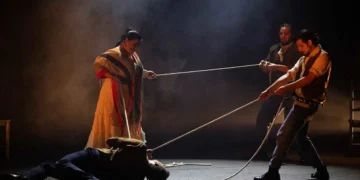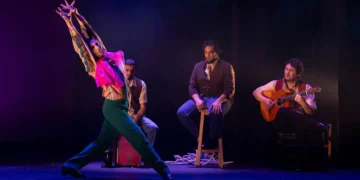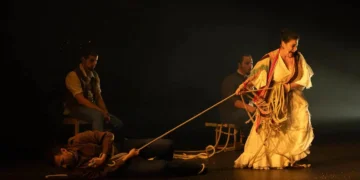|
Guadalupe Torres
|
||||||
|
Text: Pablo San Nicasio Ramos Dance: Guadalupe Torres and Marco Flores. Cante: Ismael de la Rosa and Juan José Amador. Guitar: Víctor Tomate and Claudio Villanueva. Percussion: Kike Terró Unexplored corners of flamenco The work “De los Rincones” came with a good reputation after having received prizes in several choreographic contests. That, and the wonderful group Guadalupe Torres brought along with her to lay out her concept of flamenco dance. Everything was working in the right direction for having a good time with the art of flamenco. With a full house at the cozy Teatro Pradillo there was good reason to see and hear the hour and twenty minutes the show lasted. With some ups and downs, the overall direction was upwards, and given the limited resources available, the performers, production crew and diehard followers can well feel satisfied with the results. In “De los Rincones”, young dancer Guadalupe Torres brings seven flamenco vignettes based on the premise of completely orthodox dancing with the greatest respect for the tradition of cante for dance. Seven scenes full of feeling, beginning with “Romance de la Monja” interpreted by Guadalupe with the moving background of the time-worn voice of the legendary Rafael “El Negro”. With hardly a break, serranas becomes the basis for the dance of Marcos Flores, a good friend and colleague of Guadalupe’s. A guest artist who continues to grow and whose name will be written in caps in the history of flamenco dance, no doubt about it. It’s important to underline the wisdom of choosing the style of serranas for this moment. A difficult and very flamenco cante, seldom heard these days, a flamenco delicacy. “Calma” is the moment the intensity is really cranked up in a show which is a triple-force effort. On the one hand, the guitarists who engage in an important technical discourse. On another level, the singers who constantly challenge one another and exhibit their technical prowess, especially the dance couple who never cease to communicate in their virtuosity. The taranto that paves the way for various styles of tangos, is the taking-off point, as we said, for an idea that can now show it’s best face. A very emotional choreography of abandolaos from the extraordinary Marcos Flores, is followed by another, a no less moving soleá with mantón by Guadalupe. With the interlude “Tres Morillas”, the voice of Ismael de la Rosa shines more than at any other moment. And the zorongo. Once again we return to the hidden treasures of flamenco. A high point of the show with styles such as this which, in the era of bulerías and tanguitos, have a powerful degree of richness. But in the desire not to exploit them, they become all the more exotic and luminous when they are rediscovered. Very good level in the dance couple who managed to make this number something more than just another dance. Minera and cantiñas end with the voice of Niño de Marchena who recited “Romance a Córdoba” with the shadows of Guadalupe carrying the rhythm. A well-rounded work that squeezes out the best of seven interpreters, and spends maximum energy without moving away from tradition. Because serrana, jabera and zorongo couldn’t be more traditional. Nearly hidden corners of flamenco that must never be forgotten. And there they are, for anyone wishing to use them. |
Descubre más desde Revista DeFlamenco.com
Suscríbete y recibe las últimas entradas en tu correo electrónico.
































